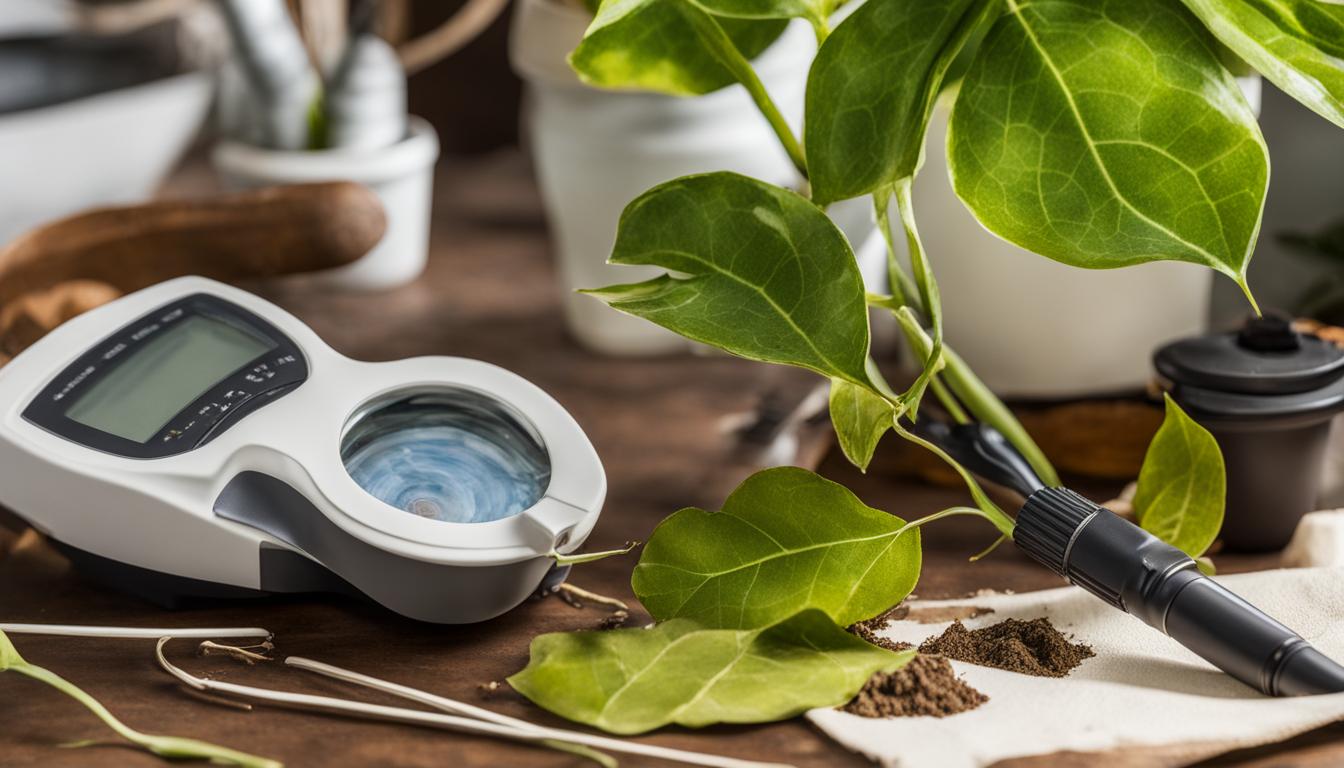
Welcome to my guide on how to spot nutrient deficiencies in indoor plants! As a plant enthusiast, I understand the importance of maintaining the health of our green companions.
Nutrient imbalances can have a significant impact on the well-being and growth of indoor plants. By learning to recognize visual clues, you can identify and address common nutrient deficiencies, ensuring your plants thrive.
Key Takeaways:
- Spotting nutrient deficiencies in indoor plants is crucial for maintaining their overall health.
- Visual clues, such as leaf discoloration or distortion, can help identify nutrient imbalances.
- Nutrient imbalances can hinder optimal plant growth and development.
- Understanding the importance of nutrients and their deficiencies is essential for proactive care.
- Consulting with a plant nutrition expert can provide accurate diagnosis and treatment recommendations.
Importance of Nutrients for Plant Health
Nutrients play a crucial role in maintaining the overall health and well-being of indoor plants. Adequate nutrient levels are essential for promoting optimal plant growth and development.
Without the necessary nutrients, plants become more susceptible to nutrient deficiencies and imbalances, which can negatively impact their overall health and vitality.
Proper nutrient intake is vital for plants to complete their natural lifecycle and achieve their full potential. Nutrient deficiencies can lead to stunted growth, reduced yield, and in severe cases, plant death.
By understanding the importance of nutrients, indoor gardeners can take the necessary steps to prevent and address nutrient deficiencies before they cause significant harm to their plants.
The Role of Nutrients in Plant Health
Each nutrient has a specific function in supporting plant health and growth. Macronutrients, such as nitrogen, phosphorus, and potassium, are required in larger quantities and are involved in various physiological processes, including photosynthesis, energy production, and root development.
On the other hand, micronutrients, such as iron, zinc, and manganese, are needed in smaller amounts but are equally important for plant health, as they are involved in enzyme activation and other essential metabolic processes.
To ensure optimal plant health, it is crucial to maintain a balanced nutrient supply. A well-balanced nutrient solution provides plants with the necessary elements they need to thrive.
Regular monitoring of nutrient levels and adjustments to the nutrient solution can help prevent deficiencies and imbalances, promoting the overall health and vitality of indoor plants.
Understanding the importance of nutrients is vital for maintaining the health of indoor plants. Nutrient deficiencies and imbalances can hinder plant growth and development, leading to stunted growth, reduced yield, and even plant death.
By providing the right balance of macronutrients and micronutrients, indoor gardeners can ensure optimal plant health and promote vigorous growth and vitality in their plants.
What Are Nutrient Deficiencies?
Nutrient deficiencies occur when plants do not receive an adequate supply of essential elements. These essential elements can be divided into two categories: macronutrients and micronutrients.
Macronutrients, such as nitrogen, phosphorus, potassium, calcium, sulfur, and magnesium, are required in larger amounts. On the other hand, micronutrients, including boron, copper, iron, manganese, molybdenum, and zinc, are needed in smaller quantities.
The availability of these essential elements in the growing medium is crucial for the proper development and growth of plants. Nutrient deficiencies can occur when there is a lack of these elements in the soil or when there are imbalances in the nutrient solution provided to the plants.
Macronutrients
Macronutrient deficiencies can have a significant impact on plant health. For example, a nitrogen deficiency can result in slow growth, pale leaves, and reduced overall vigor.
Phosphorus deficiency may lead to stunted growth and a purplish coloration in the leaves. Lack of potassium can cause yellowing of leaf edges and overall weak plant development.
Calcium deficiency can result in blossom end rot in fruiting plants, while magnesium deficiency may lead to yellowing of older leaves.
Micronutrients
Micronutrient deficiencies can also have detrimental effects on plant health. Iron deficiency can cause yellowing of leaves with green veins, while zinc deficiency may result in stunted growth and yellowing between leaf veins.
Boron deficiency can lead to brittle or twisted growth, and copper deficiency can cause chlorosis or a pale green color in leaves. Manganese deficiency may result in yellowing between leaf veins, and molybdenum deficiency can cause leaf yellowing and sticky secretions.
| Nutrient | Deficiency Symptoms |
|---|---|
| Nitrogen | Slow growth, pale leaves |
| Phosphorus | Stunted growth, purplish leaves |
| Potassium | Yellowing leaf edges, weak development |
| Calcium | Blossom end rot in fruiting plants |
| Magnesium | Yellowing of older leaves |
| Iron | Yellowing leaves with green veins |
| Zinc | Stunted growth, yellowing between leaf veins |
| Boron | Brittle or twisted growth |
| Copper | Chlorosis, pale green leaves |
| Manganese | Yellowing between leaf veins |
| Molybdenum | Leaf yellowing, sticky secretions |
Common Symptoms of Nutrient Deficiency
When it comes to identifying nutrient deficiencies in indoor plants, paying attention to common symptoms is crucial. These symptoms can provide valuable insights into the health and wellbeing of your plants. Here are some key indicators to look out for:
Leaf Discoloration:
One of the most noticeable signs of nutrient deficiency is leaf discoloration. This can manifest as yellowing, browning, or even purplish hues in the leaves. Discoloration can occur uniformly or in specific patterns, depending on the nutrient lacking in the plant’s system.
Leaf Distortion:
In addition to discoloration, nutrient deficiencies can also cause leaf distortion. Leaves may become misshapen, twisted, or have unusual spots or holes. These changes in leaf structure can indicate that the plant is struggling to develop properly due to a lack of essential nutrients.
Stunted Growth and Yield Differences:
Another telltale sign of nutrient deficiencies is stunted growth. If your plants are not growing as expected or are significantly smaller than they should be, it could be a sign that they are lacking vital nutrients.
Nutrient deficiencies can also impact the yield of your plants, resulting in lower productivity compared to healthy plants of the same species.
By recognizing these common symptoms of nutrient deficiency, you can take the necessary steps to address the issue and ensure the optimal health and growth of your indoor plants.
Identifying Nutrient Deficiencies: Before You Start Treatment
Before treating a potential nutrient deficiency in your indoor plants, it is important to take certain steps to ensure accurate diagnosis and effective treatment. By considering other factors that may be affecting plant health, you can narrow down the possibilities and address the issue more efficiently.
Check for Pests and Diseases
Pests and diseases can often mimic the symptoms of nutrient deficiencies. Therefore, it is crucial to carefully inspect your plants for any signs of infestation or infection.
Look for pests such as aphids, spider mites, and whiteflies, as well as common diseases like powdery mildew or fungal infections.
If you notice any abnormalities, it is recommended to take appropriate measures to control the pest or disease before proceeding with nutrient deficiency treatment.
Assess Soil and Water Quality
The quality of your soil and water can significantly impact plant health. Conduct a thorough analysis of your soil to determine its nutrient composition and pH levels.
This information will help you identify any existing nutrient imbalances or deficiencies. Similarly, evaluate the quality of the water you use for irrigation.
Poor water quality, such as high levels of chlorine or heavy metals, can affect nutrient uptake by plants. If necessary, consider using filtered or distilled water for optimal plant health.
Evaluate Growing Conditions
Indoor plants require specific growing conditions to thrive. Assess factors such as temperature, humidity, and light exposure in your growing environment.
Extreme temperatures or fluctuations can stress plants and hinder nutrient absorption. Inadequate or excessive light can also impact plant growth and nutrient utilization.
By ensuring that your plants are provided with optimal growing conditions, you can minimize the risk of nutrient deficiencies.
Consult an Expert
If you are uncertain about the underlying cause of your indoor plants’ health issues or need guidance in addressing nutrient deficiencies, it is advisable to seek professional assistance.
A plant nutrition expert or horticulturist can provide valuable insights and offer tailored recommendations based on your specific situation.
Their expertise will help you identify and treat nutrient deficiencies effectively, ensuring the long-term health and vitality of your indoor plants.
By following these steps and thoroughly evaluating the conditions and potential factors affecting your indoor plants, you can better identify nutrient deficiencies and take appropriate action.
Remember to address any pest or disease issues, assess soil and water quality, evaluate growing conditions, and consult an expert when needed.
Taking these measures will significantly contribute to the success of your plant care efforts and the overall health of your indoor plants.
Macronutrient Deficiencies: Symptoms and Remedies
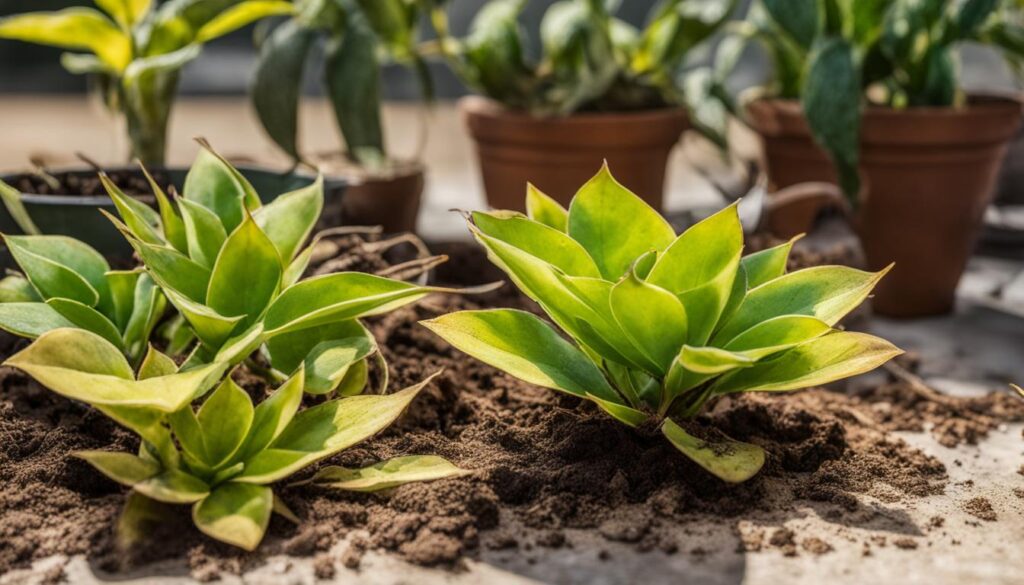
Macronutrients are essential elements that plants require in larger quantities for optimal growth and development. However, deficiencies in these nutrients can lead to a range of symptoms in indoor plants.
By recognizing these symptoms, you can take appropriate measures to address and remedy nutrient deficiencies. Here are some common macronutrient deficiencies and their associated symptoms:
Nitrogen Deficiency:
A nitrogen deficiency in indoor plants can be characterized by yellowing of the lower leaves, weak growth, and overall pale appearance.
Nitrogen is vital for leaf and stem development, so a lack of this nutrient can greatly impact plant growth. To remedy nitrogen deficiency, you can use a nitrogen-rich fertilizer or organic compost to replenish the nutrient levels in the soil.
Phosphorus Deficiency:
Phosphorus is crucial for energy transfer and root development in plants. A phosphorus deficiency can cause dark green leaves, bronze or red discoloration, and stunted growth.
To address phosphorus deficiency, you can use a phosphorus-rich fertilizer or add bone meal to the soil, which is a natural source of phosphorus.
Potassium Deficiency:
Potassium deficiency can manifest as brown or burnt-looking leaf edges, chlorosis (yellowing) between leaf veins, and purple spots on the leaves.
Potassium plays a vital role in overall plant health and is essential for nutrient uptake, flowering, and fruit development. To remedy potassium deficiency, you can apply a potassium-rich fertilizer or use potassium sulfate as a supplement.
Calcium Deficiency:
Calcium deficiency in indoor plants can affect leaf tip growth and cause wilting. Calcium is essential for cell wall formation and the prevention of disorders such as blossom end rot in fruits.
To address calcium deficiency, you can use a calcium-rich fertilizer or apply gypsum, which is a good source of calcium, to the soil.
Magnesium Deficiency:
Magnesium deficiency can cause yellowing between leaf veins, a condition known as interveinal chlorosis. Magnesium is a central component of chlorophyll and is essential for photosynthesis.
To remedy magnesium deficiency, you can apply a magnesium-rich fertilizer or use Epsom salts as a supplement.
Sulfur Deficiency:
Sulfur deficiency may result in yellowing of leaves with pale green veins. Sulfur is essential for protein synthesis, enzyme activity, and the formation of essential oils in plants.
To address sulfur deficiency, you can apply a sulfur-rich fertilizer or use elemental sulfur as a supplement.
Recognizing and addressing macronutrient deficiencies in indoor plants is essential for maintaining their health and promoting optimal growth.
By understanding the symptoms associated with each deficiency and using appropriate remedies, you can ensure that your indoor plants receive the necessary nutrients for their overall well-being.
Micronutrient Deficiencies: Symptoms and Solutions
Micronutrient deficiencies can have significant impacts on the health and growth of indoor plants. It is important to recognize the symptoms of these deficiencies and take appropriate action to address them.
In this section, we will explore the common symptoms of micronutrient deficiencies and discuss solutions to overcome them.
Iron Deficiency
One of the most common micronutrient deficiencies in indoor plants is iron deficiency. Plants lacking iron may exhibit yellowing leaves with green veins, a condition known as chlorosis.
To address this deficiency, foliar sprays or root drenches containing iron chelates can be used. Incorporating organic matter rich in iron, such as compost or manure, into the soil can help replenish iron levels.
Zinc Deficiency
Zinc deficiency can resemble iron deficiency and often leads to poor growth in plants. Symptoms may include stunted shoots and leaves with distorted or smaller size.
Treating zinc deficiency involves applying zinc sulfate or other zinc-containing fertilizers to the soil. It is important to follow recommended application rates and frequency to avoid overloading the plants with excessive zinc.
Boron Deficiency
Boron deficiency can cause significant damage to indoor plants, resulting in dead apical buds and root rot. To address this deficiency, it is recommended to apply boron-containing fertilizers or foliar sprays. Additionally, maintaining proper pH levels in the soil can help enhance the availability of boron to plants.
Copper Deficiency
Indoor plants with copper deficiency may exhibit dark green leaves and stunted growth. To overcome this deficiency, foliar sprays containing copper sulfate or copper chelates can be used. Incorporating compost or organic matter rich in copper can also help restore copper levels in the soil.
Manganese Deficiency
Manganese deficiency can result in yellowing between leaf veins and poor plant growth. To address this deficiency, it is recommended to apply manganese sulfate or other manganese-containing fertilizers to the soil. Regular soil testing can help determine the appropriate application rates for manganese amendments.
Molybdenum Deficiency
Molybdenum deficiency can cause yellowing leaves and sticky secretions in indoor plants. To overcome this deficiency, applying molybdenum-containing fertilizers or foliar sprays can be beneficial. Additionally, ensuring proper pH levels and organic matter content in the soil can improve molybdenum availability.
By recognizing the symptoms of micronutrient deficiencies and implementing the appropriate solutions, you can ensure the health and vitality of your indoor plants. Regular soil testing and monitoring of plant health are crucial in addressing and preventing these deficiencies for optimal growth and development.
| Micronutrient | Symptoms | Solutions |
|---|---|---|
| Iron | Yellowing leaves with green veins (chlorosis) | Apply iron chelates or incorporate iron-rich organic matter into the soil |
| Zinc | Poor growth, stunted shoots, distorted leaves | Apply zinc sulfate or zinc-containing fertilizers to the soil |
| Boron | Dead apical buds, root rot | Apply boron-containing fertilizers or maintain proper soil pH levels |
| Copper | Dark green leaves, stunted growth | Apply copper sulfate or copper chelates, incorporate copper-rich organic matter |
| Manganese | Yellowing between leaf veins, poor growth | Apply manganese sulfate or manganese-containing fertilizers, conduct regular soil testing |
| Molybdenum | Yellowing leaves, sticky secretions | Apply molybdenum-containing fertilizers or foliar sprays, maintain proper pH and organic matter in soil |
Preventing Nutrient Deficiencies
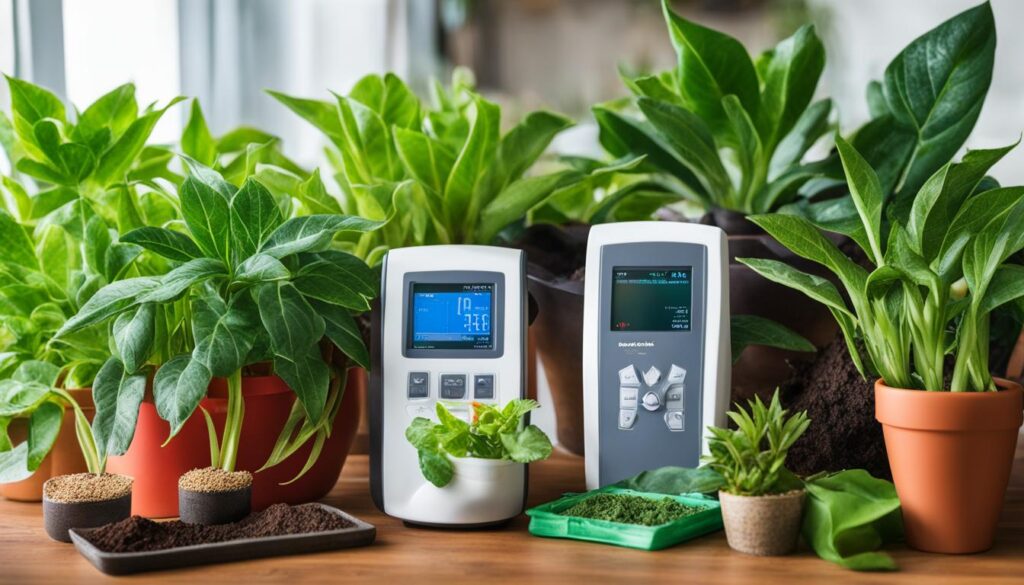
Preventing nutrient deficiencies is essential for maintaining the health and vitality of your indoor plants. By implementing a range of strategies, you can ensure that your plants have access to a balanced nutrient solution and optimal growing conditions.
1. Balanced Nutrient Solutions
One of the key prevention strategies is to provide your plants with a balanced nutrient solution. This involves incorporating the right ratios of macronutrients and micronutrients to meet their specific needs. Regularly monitoring nutrient levels and adjusting the solution accordingly can help prevent deficiencies from occurring.
2. Soil and Water Analysis
Conducting soil and water analysis is crucial for identifying any potential nutrient deficiencies or imbalances. Soil analysis can provide insights into the nutrient content and pH levels of your growing medium, allowing you to make informed decisions about nutrient supplementation.
Similarly, water analysis can help you understand the quality of your irrigation water and identify any mineral deficiencies or excesses that may affect plant health.
3. pH Monitoring
Monitoring the pH levels of your soil and nutrient solution is another important aspect of preventing nutrient deficiencies. Different plants have specific pH preferences, and maintaining the appropriate pH range can optimize nutrient availability and absorption.
Regularly testing and adjusting the pH can help ensure that your plants have access to the nutrients they need.
By following these prevention strategies and regularly monitoring your indoor plants, you can avoid nutrient deficiencies and promote their overall health and well-being.
Remember to consult with a plant nutrition expert for personalized advice and guidance based on your specific plant species and growing conditions.
Treating Nutrient Deficiencies
When it comes to addressing nutrient deficiencies in indoor plants, there are various treatment approaches you can consider. Whether you prefer organic solutions or more conventional methods, the key is to choose the approach that best suits your plants and addresses the specific deficiencies they are facing.
One organic solution is to create nutrient teas using compost or specific plant materials. These teas can be made by steeping compost or plant matter in water and then applying the resulting liquid to your plants. Nutrient teas provide a natural source of essential elements and can help replenish nutrients in the soil.
Composting is another effective way to treat nutrient deficiencies. By adding organic matter, such as kitchen scraps, leaves, or grass clippings, to your soil, you can improve its structure and nutrient content over time. Compost acts as a slow-release fertilizer, providing a steady supply of nutrients to your plants.
In addition to organic solutions, correcting deficiencies may involve adjusting nutrient solutions or using specific additives.
Conducting a soil analysis can help identify which nutrients are lacking and guide you in choosing the appropriate additives or fertilizers. It’s important to follow the recommended application rates and schedules to avoid over or under-fertilization.
Treatment Approaches for Nutrient Deficiencies
| Nutrient Deficiency | Treatment Approach |
|---|---|
| Nitrogen Deficiency | Adjust nutrient solution with nitrogen-based fertilizers |
| Phosphorus Deficiency | Apply phosphorus-rich fertilizers or additives |
| Potassium Deficiency | Use potassium-rich fertilizers or additives |
| Calcium Deficiency | Apply calcium supplements or adjust pH levels |
| Magnesium Deficiency | Use magnesium sulfate or other magnesium-based supplements |
| Sulfur Deficiency | Add elemental sulfur or sulfur-containing fertilizers |
Remember, it’s important to diagnose the specific nutrient deficiencies before beginning treatment. If you’re unsure about the exact deficiencies your plants are experiencing, consulting a plant nutrition expert can provide you with accurate diagnosis and tailored treatment recommendations.
Maintaining Indoor Plant Health
As an indoor plant enthusiast, I understand the importance of providing proper care and attention to our green companions. Nutrient deficiencies can have a significant impact on the health and growth of indoor plants, but by implementing preventive measures and addressing deficiencies promptly, we can ensure optimal plant growth.
Indoor plant care begins with regular monitoring of plant health. By keeping a close eye on our plants, we can quickly spot any signs of nutrient deficiencies. Whether it’s yellowing leaves, stunted growth, or discoloration, these visual clues serve as valuable indicators that our plants need our help.
Prevention is key when it comes to maintaining the health of our indoor plants. By using balanced nutrient solutions, conducting soil and water analysis, monitoring pH levels, and ensuring proper watering and drainage, we can create an environment that is less prone to nutrient deficiencies.
Taking these preventive measures can significantly reduce the risk of our plants experiencing deficiencies in the first place.
By understanding the signs of nutrient deficiencies and taking appropriate action, we can promote optimal plant growth and vitality. Remember, our indoor plants rely on us for their well-being, and with a little care and attention, we can keep them thriving for years to come.
FAQ
Can nutrient imbalances affect the health of indoor plants?
Yes, nutrient imbalances can prevent plants from growing optimally and completing their natural lifecycle.
How can I identify nutrient deficiencies in my indoor plants?
By recognizing visual clues such as leaf discoloration or distortion, you can identify nutrient deficiencies in your plants.
What are macronutrients and micronutrients?
Macronutrients are essential elements required in larger amounts, including nitrogen, phosphorus, potassium, calcium, sulfur, and magnesium. Micronutrients are needed in smaller quantities and include boron, copper, iron, manganese, molybdenum, and zinc.
What are the common symptoms of nutrient deficiencies in indoor plants?
Common symptoms include yellow or brown leaves, holes in leaves, burnt or scorched appearance, purple or red tones, yellowing between leaf veins, small or stunted leaves, spots on leaves, and twisted or misshaped leaves.
What should I do before treating a potential nutrient deficiency in my plants?
It is important to rule out other factors that may be affecting plant health, such as pests or diseases, soil moisture and composition, water quality and temperature, and pH levels. If unsure, consult a plant nutrition expert for accurate diagnosis and treatment recommendations.
What are some common macronutrient deficiencies and their symptoms?
Nitrogen deficiency may result in yellowing lower leaves and weak growth. Phosphorus deficiency can cause dark green leaves, bronze or red discoloration, and stunted growth. Potassium deficiency may lead to brown or burnt-looking leaf edges, chlorosis between leaf veins, and purple spots. Calcium deficiency can affect leaf tip growth and cause wilting. Magnesium deficiency can cause yellowing between leaf veins. Sulfur deficiency may result in yellowing of leaves with pale green veins.
What are some common micronutrient deficiencies and their symptoms?
Iron deficiency may cause yellowing leaves with green veins. Zinc deficiency can resemble iron deficiency and lead to poor growth. Boron deficiency can result in dead apical buds and root rot. Copper deficiency can cause dark green and stunted leaves. Manganese deficiency may show yellowing between veins. Molybdenum deficiency can cause yellowing leaves and sticky secretions.
How can I prevent nutrient deficiencies in my indoor plants?
Implement strategies such as using balanced nutrient solutions, conducting soil and water analysis, adjusting pH levels, and ensuring proper watering and drainage.
How can I treat nutrient deficiencies in indoor plants?
Treatment approaches include using organic solutions like nutrient teas made from compost, adjusting nutrient solutions, adding specific additives, or using soil amendments to correct deficiencies.
How can I maintain the health of my indoor plants?
Regularly monitor plant health and nutrient levels, implement preventive measures, and address nutrient deficiencies promptly to promote optimal plant growth and vitality.



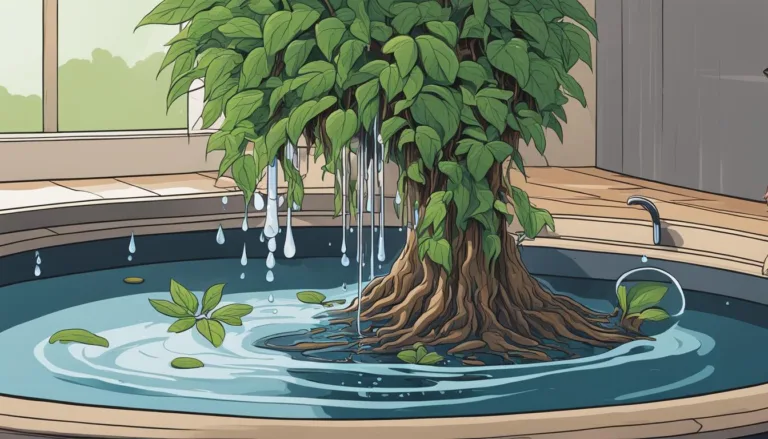


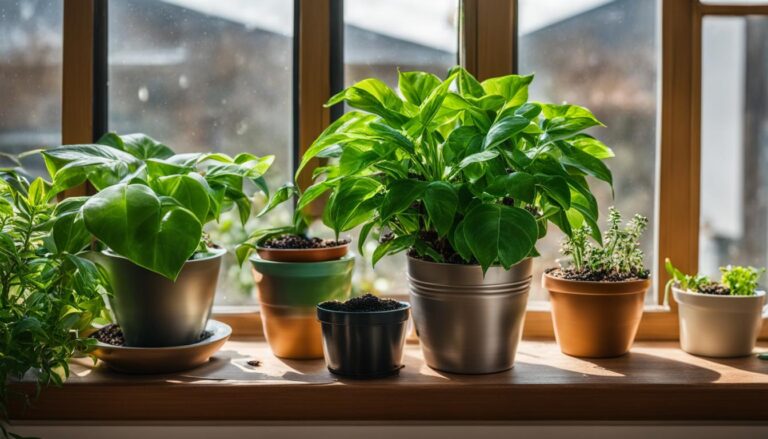
One Comment
Comments are closed.